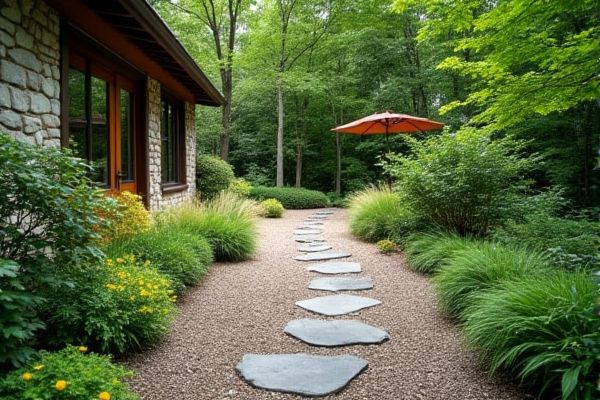
Gravel paths offer a flexible, low-maintenance solution with excellent drainage, while stepping stone paths provide a more structured and decorative look that guides your footsteps precisely. Discover which type best complements your outdoor space by reading the rest of the article.
Table of Comparison
| Feature | Gravel Path | Stepping Stone Path |
|---|---|---|
| Material | Crushed stone or pea gravel | Concrete, natural stone, or pavers |
| Installation | Easy, requires edging and leveling | Moderate, involves precise placement |
| Maintenance | Occasional raking and replenishing gravel | Minimal, occasional cleaning |
| Drainage | Excellent water drainage | Good, depends on substrate and spacing |
| Durability | Long-lasting if maintained | Highly durable and stable |
| Appearance | Casual, rustic look | Structured, formal appearance |
| Comfort | Uneven underfoot, may shift | Stable, comfortable to walk on |
| Cost | Lower initial cost | Higher initial cost |
Introduction to Garden Path Options
Gravel paths offer a cost-effective, permeable surface that enhances drainage and provides a rustic look, while stepping stone paths create a defined walkway with customizable materials and patterns, adding visual interest and structure to your garden. Gravel requires less maintenance but may shift over time, whereas stepping stones demand regular upkeep to prevent weed growth and keep stones level. Your choice depends on balancing aesthetics, maintenance effort, and garden design goals.
Overview: Gravel Paths vs Stepping Stone Paths
Gravel paths offer a flexible, cost-effective option that provides excellent drainage and a natural aesthetic, while stepping stone paths create defined walkways with a more structured, artistic appeal. Gravel is ideal for larger areas and easier installation, whereas stepping stones require careful placement and maintenance to ensure stability and safety. Your choice depends on the desired look, budget, and the functionality needed for your outdoor space.
Aesthetic Appeal and Design Flexibility
Gravel paths offer a natural, textured aesthetic that blends seamlessly with garden landscapes, while stepping stone paths provide a clean, structured look with distinct shapes and patterns. The design flexibility of gravel allows for easy reshaping and integration with various outdoor elements, whereas stepping stones enable precise layout customization to create artistic walkways. Your choice depends on whether you prioritize the organic charm of gravel or the crisp geometry and visual definition that stepping stones bring to your outdoor space.
Installation Process and Ease
Gravel path installation involves spreading and leveling a gravel base, often requiring a weed barrier and edging to maintain structure, making it a quick and cost-effective option. Stepping stone paths demand precise placement of stones on a stable base or sand bed, with more labor-intensive alignment and spacing to ensure safety and aesthetic appeal. Gravel paths generally offer faster installation, while stepping stone paths require greater attention to detail for a polished finish.
Cost Comparison and Budget Considerations
Gravel paths typically cost between $1 and $3 per square foot, making them a more budget-friendly option compared to stepping stone paths, which range from $5 to $15 per square foot depending on the material and installation complexity. Gravel requires less labor and fewer materials, reducing overall expenses and maintenance costs, while stepping stones involve higher initial investment due to materials like natural stone or concrete pavers and professional installation. Homeowners should weigh their budget constraints against desired aesthetics and durability when choosing between gravel and stepping stone pathways.
Durability and Maintenance Requirements
Gravel paths offer excellent durability with proper edging and occasional replenishment to maintain their appearance, but they may require regular raking to prevent displacement and weed growth. Stepping stone paths provide a low-maintenance option, as stones are long-lasting and resist weathering, though the surrounding ground may need occasional leveling and weed control. Your choice depends on balancing the minimal upkeep of stepping stones against the flexible, yet more maintenance-intensive nature of gravel paths.
Safety and Accessibility Factors
Gravel paths may pose challenges for individuals with mobility aids due to uneven surfaces and loose stones, increasing the risk of slips and trips. Stepping stone paths offer a firmer, more stable footing but require careful spacing to ensure safe and accessible navigation, particularly for those with limited mobility. Proper installation and maintenance of both path types are crucial to maximize safety and accommodate diverse accessibility needs.
Drainage and Environmental Impact
Gravel paths provide excellent drainage by allowing water to permeate naturally into the ground, reducing runoff and preventing erosion. Stepping stone paths can concentrate water flow around the stones, potentially leading to soil compaction and localized drainage issues if not properly installed. Your choice between gravel and stepping stones should consider how each material affects groundwater absorption and environmental sustainability in your landscape design.
Best Uses for Gravel Paths
Gravel paths are ideal for creating durable, low-maintenance walkways in gardens, driveways, or informal outdoor spaces due to their excellent drainage and ability to prevent mud. They work best in areas with heavy foot traffic or where you want a rustic, natural look that complements surrounding landscaping. Gravel paths are also cost-effective and easy to install, making them suitable for large-scale projects or budget-conscious landscaping.
Best Uses for Stepping Stone Paths
Stepping stone paths are ideal for garden walkways, naturalistic landscapes, and areas requiring minimal soil disturbance, providing clear guidance while preserving the surrounding vegetation. They excel in spaces needing precise navigation, such as over delicate ground covers or uneven terrain, where a solid, stable surface is essential. Stepping stones can also serve decorative purposes, highlighting focal points or leading to patios, water features, and seating areas with an organic, flexible layout.
 homyna.com
homyna.com